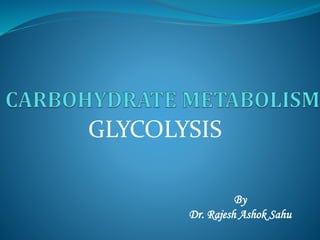Glycolysis.pptx
•Download as PPTX, PDF•
0 likes•188 views
Glycolysis
Report
Share
Report
Share

Recommended
Recommended
More Related Content
What's hot
What's hot (20)
Biological oxidation and Electron transport chain (ETC).pptx

Biological oxidation and Electron transport chain (ETC).pptx
Similar to Glycolysis.pptx
Similar to Glycolysis.pptx (20)
Glycolysis-general introduction and pathway with biochemical logic

Glycolysis-general introduction and pathway with biochemical logic
carbohydrate metabolism, Glycolysis, metabolic process of carbohydrates, EMP ...

carbohydrate metabolism, Glycolysis, metabolic process of carbohydrates, EMP ...
A Classroom Lecture on Cell Metabolism. By: Dr. Ozair Chaudhry

A Classroom Lecture on Cell Metabolism. By: Dr. Ozair Chaudhry
Recently uploaded
Antibiotics are medicines that fight infections caused by bacteria in humans and animals by either killing the bacteria or making it difficult for the bacteria to grow and multiply. Bacteria are germsABHISHEK ANTIBIOTICS PPT MICROBIOLOGY // USES OF ANTIOBIOTICS TYPES OF ANTIB...

ABHISHEK ANTIBIOTICS PPT MICROBIOLOGY // USES OF ANTIOBIOTICS TYPES OF ANTIB...ABHISHEK SONI NIMT INSTITUTE OF MEDICAL AND PARAMEDCIAL SCIENCES , GOVT PG COLLEGE NOIDA
Recently uploaded (20)
The Mariana Trench remarkable geological features on Earth.pptx

The Mariana Trench remarkable geological features on Earth.pptx
Porella : features, morphology, anatomy, reproduction etc.

Porella : features, morphology, anatomy, reproduction etc.
Selaginella: features, morphology ,anatomy and reproduction.

Selaginella: features, morphology ,anatomy and reproduction.
Pteris : features, anatomy, morphology and lifecycle

Pteris : features, anatomy, morphology and lifecycle
PATNA CALL GIRLS 8617370543 LOW PRICE ESCORT SERVICE

PATNA CALL GIRLS 8617370543 LOW PRICE ESCORT SERVICE
ABHISHEK ANTIBIOTICS PPT MICROBIOLOGY // USES OF ANTIOBIOTICS TYPES OF ANTIB...

ABHISHEK ANTIBIOTICS PPT MICROBIOLOGY // USES OF ANTIOBIOTICS TYPES OF ANTIB...
Genome Projects : Human, Rice,Wheat,E coli and Arabidopsis.

Genome Projects : Human, Rice,Wheat,E coli and Arabidopsis.
Understanding Partial Differential Equations: Types and Solution Methods

Understanding Partial Differential Equations: Types and Solution Methods
GBSN - Biochemistry (Unit 2) Basic concept of organic chemistry 

GBSN - Biochemistry (Unit 2) Basic concept of organic chemistry
Site specific recombination and transposition.........pdf

Site specific recombination and transposition.........pdf
Thyroid Physiology_Dr.E. Muralinath_ Associate Professor

Thyroid Physiology_Dr.E. Muralinath_ Associate Professor
Bhiwandi Bhiwandi ❤CALL GIRL 7870993772 ❤CALL GIRLS ESCORT SERVICE In Bhiwan...

Bhiwandi Bhiwandi ❤CALL GIRL 7870993772 ❤CALL GIRLS ESCORT SERVICE In Bhiwan...
Role of AI in seed science Predictive modelling and Beyond.pptx

Role of AI in seed science Predictive modelling and Beyond.pptx
TransientOffsetin14CAftertheCarringtonEventRecordedbyPolarTreeRings

TransientOffsetin14CAftertheCarringtonEventRecordedbyPolarTreeRings
LUNULARIA -features, morphology, anatomy ,reproduction etc.

LUNULARIA -features, morphology, anatomy ,reproduction etc.
development of diagnostic enzyme assay to detect leuser virus

development of diagnostic enzyme assay to detect leuser virus
Glycolysis.pptx
- 1. GLYCOLYSIS By Dr. Rajesh Ashok Sahu
- 2. What is Glycolysis? Glycolysis is the sequence of reactions that convert glucose into pyruvate in the presence of oxygen (aerobic) or lactate in the absence of oxygen (anaerobic) with the production of ATP. Embden Meyerhof pathway. Location: Cytosol of all cells / Cytoplasm. Pathway: The breakdown of glucose (6-carbon compound) to two moles of pyruvate (3-carbon compound) is brought about by sequential action of ten enzymes which can be divided into two phases. Ist phase: Energy requiring phase or preparative phase IInd phase: Energy generating phase.
- 4. Pathway of Glycolysis Phase-1 Phase-2
- 5. Keys to remember: Starting substrate: Glucose End product: Pyruvate(Aerobic) & Lactate (Anaerobic) Total Substrate: 12 ( countable 11) Total Steps: 11 (Countable 10) Total Enzymes: 11 ATP: -1, -3 & +6, +9. NAD: 5 , 10 Water: 8
- 6. Energetics of Glycolysis: Net production of ATP in aerobic glycolysis = Number of ATP produced minus number of ATPs consumed = 10 – 2 = 8 It is assumed that NADH formed in glycolysis uses malate shuttle to produce 6 ATPs Total ATP per molecule of glucose under anaerobic glycolysis = 2 Reaction Reaction catalyzed by No. of ATP formed or consumed per glucose molecule Glucose to glucose-6-phosphate Hexokinase, glucokinase -1 Fructoe-6-phosphate to fructose 1,6 biphosphate Phosphofructokinase -1 Glyceraldehyde-3-phosphate to 1,3- bisphosphoglycerate Glyceraldehyde-3-phosphate dehydrogenase +6* 1,3-bisphosphoglycerate to 3- phosphoglycerate Phosphoglycerate kinase +2 Phosphoenolpyruvate to Pyruvate Pyruvate kinase +2
- 7. Under anaerobic conditions [oxidation of glucose to lactate] Total ATP used = 2 ……….. as follows, One ATP in the activation of glucose to glucose-6-phosphate. One ATP in the activation of fructose-6-phosphate to fructose1,6-bisphosphate. Total ATP gained = 4 ………. as follows, 2 ATP by substrate level phosphorylation from 1,3-bis phosphoglycerate 2 ATP from substrate level phosphorylation from phosphoenol - pyruvate. Net ATP gained = 4 ATP gained - 2 ATP used = 2 ATP
- 8. : Under Aerobic conditions Total ATP used = 2 ATP as under Anaerobic conditions Total ATP gained = 10 ATP, generated as follows, 4 ATP (obtained by substrate level phosphorylation) + 6 ATP, obtained after complete oxidation of 2 NADH molecules in respiratory chain. Net ATP gained = 8 ATP as follows, 10 ATP gained – 2 ATP used = 8 ATP
- 9. Significance: Glycolysis -principal route -glucose metabolism. Glycolysis provides ATP. It provides pyruvate needed for Krebs' cycle. Generates precursors for biosynthetic pathway, e.g. Pyruvate amino acid (alanine). pyruvate acetyl-CoA fatty acid. Glycerol-3-phosphate triacylglycerol Reversal of glycolysis [ with 3 more steps] is gluconeogenesis, an important source of glucose.
- 10. Comparison of Aerobic and Anaerobic Glycolysis Occurs in presence of oxygen Pyruvate is the end product Oxidation of NADH in the electron transport chain. 08 Net ATP produced Occurs in absence of oxygen Lactate is the end product. No oxidation of NADH in the electron transport chain. 02 Net ATP produced